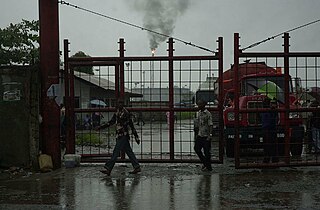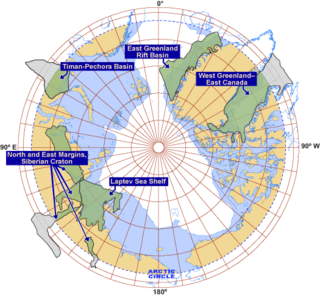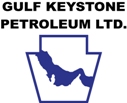Related Research Articles

The history of the petroleum industry in the United States goes back to the early 19th century, although the indigenous peoples, like many ancient societies, have used petroleum seeps since prehistoric times; where found, these seeps signaled the growth of the industry from the earliest discoveries to the more recent.

The National Iranian Oil Company is a government-owned national oil and natural gas producer and distributor under the direction of the Ministry of Petroleum of Iran. NIOC was established in 1948 and restructured under The Consortium Agreement of 1954. NIOC ranks as the world's second largest oil company, after Saudi Arabia's state-owned Aramco.
The oil and gas industry is usually divided into three major sectors: upstream, midstream and downstream. The upstream sector includes searching for potential underground or underwater crude oil and natural gas fields, drilling exploratory wells, and subsequently operating the wells that recover and bring the crude oil or raw natural gas to the surface.

The China National Petroleum Corporation (CNPC) is a major national oil and gas corporation of China and one of the largest integrated energy groups in the world. Its headquarters are in Dongcheng District, Beijing. CNPC was ranked fourth in 2022 Fortune Global 500, a global ranking of the largest corporations by revenue.

Nigeria is the second largest oil and gas producer in Africa. Crude oil from the Niger Delta basin comes in two types: light, and comparatively heavy – the lighter has around 36 of API gravity while the heavier has 20–25 of API gravity. Both types are paraffinic and low in Sulphur. Nigeria's economy and budget have been largely supported from income and revenues generated from the petroleum industry since 1960. Statistics as at February 2021 shows that the Nigerian oil sector contributes to about 9% of the entire GDP of the nation. Nigeria is a major exporter of crude oil and petroleum products to the United States of America. In 2010, Nigeria exported over one million barrels per day to the United States, representing 9% of the U.S. total crude oil and petroleum products imports and over 40% of Nigeria exports.

APA Corporation is the holding company for Apache Corporation, an American company engaged in hydrocarbon exploration. It is organized in Delaware and headquartered in Houston. The company is ranked 431st on the Fortune 500.
The Dalia Oil Field is an oil field in deepwater block 17, 135 kilometres (84 mi) off the coast of Cabinda, Angola. The field lies in water depths varying between 1,200 and 1,500 metres. Dalia oil field was discovered in September 1997 and brought into production in December 2006.

Exploration for petroleum in the Arctic is expensive and challenging both technically and logistically. In the offshore, sea ice can be a major factor. There have been many discoveries of oil and gas in the several Arctic basins that have seen extensive exploration over past decades but distance from existing infrastructure has often deterred development. Development and production operations in the Arctic offshore as a result of exploration have been limited, with the exception of the Barents and Norwegian seas. In Alaska, exploration subsequent to the discovery of the Prudhoe Bay oilfield has focussed on the onshore and shallow coastal waters.
Canada's early petroleum discoveries took place near population centres or along lines of penetration into the frontier.
Prudhoe Bay Oil Field is a large oil field on Alaska's North Slope. It is the largest oil field in North America, covering 213,543 acres (86,418 ha) and originally contained approximately 25 billion barrels (4.0×109 m3) of oil. The amount of recoverable oil in the field is more than double that of the next largest field in the United States by acreage (the East Texas Oil Field), while the largest by reserves is the Permian Basin (North America). The field was operated by BP; partners were ExxonMobil and ConocoPhillips until August 2019; when BP sold all its Alaska assets to Hilcorp.

The impact of the petroleum industry has been increasing globally as China ranks seventh for oil production and second in crude oil consumption in the world. China imported a record 6.7 million barrels a day (b/d) of oil in 2015 and was forecast "to overtake the U.S. as the world's biggest crude importer in 2016".

ExxonMobil Corporation is an American multinational oil and gas corporation and the largest direct descendant of John D. Rockefeller's Standard Oil. The company, which took its present name in 1999 per the merger of Exxon and Mobil, is vertically integrated across the entire oil and gas industry, and within it is also a chemicals division which produces plastic, synthetic rubber, and other chemical products. ExxonMobil is headquartered near the Houston suburb of Spring, Texas, though officially incorporated in the U.S. state of New Jersey. It is the largest United States-based oil and gas producing company. ExxonMobil is also the eighth largest company in the world by revenue and the third largest in the US.
Sources include: Dow Jones (DJ), New York Times (NYT), Wall Street Journal (WSJ), and the Washington Post (WP).

Offshore oil and gas in the Gulf of Mexico is a major source of oil and natural gas in the United States. The western and central Gulf of Mexico, which includes offshore Texas, Louisiana, Mississippi, and Alabama, is one of the major petroleum-producing areas of the United States. Oil production from US federal waters in the Gulf of Mexico reached an all-time annual high of 1.65 million barrels per day in 2017. Oil production is expected to continue the upward trend in 2018 and 2019, based on ten new oil fields which are planned to start production in those years. According to the Energy Information Administration, "Gulf of Mexico federal offshore oil production accounts for 15% of total U.S. crude oil production and federal offshore natural gas production in the Gulf accounts for 5% of total U.S. dry production."

Gulf Keystone Petroleum Limited is an independent oil and gas exploration and production company that operates in the Kurdistan region of Iraq. It is also the operator of the Shaikan oil field. The company was listed on the main market of the London Stock Exchange on September 8, 2004. Jon Harris serves as its chief executive officer.
In addition to terrestrial oil wells, Canada also extracts oil via offshore drilling.

Staatsolie, officially Staatsolie Maatschappij Suriname, is a Surinamese oil and gold company which was established to execute the oil policy which includes exploration, drilling and processing oil. In 2014 Staatsolie expanded its business to gold. Staatsolie is wholly state-owned.
Melinda Janki is a Guyanese lawyer. She was instrumental in writing into Guyana's 1995 constitution the Environmental Protection Act giving its citizens among the strongest protections of any nation, including "the right to an environment that is not harmful to his or her health or well-being."
References
- ↑ "Setting up oil refinery in Guyana even less viable now from when study first done". OilNow. 2020-06-25. Retrieved 2020-12-04.
- ↑ GTIMES (2019-10-07). "Oil refinery to be completed by next year – GuyEnergy executive". Guyana Times. Retrieved 2020-12-04.
- ↑ KNEWS (2024-05-22). "Guyana is now 3rd largest non-OPEC oil supplier globally". Kaieteur News. Retrieved 2024-05-24.
- ↑ Espinasa, Ramon (September 2008). "Prospects for the Oil-Importing Countries of the Caribbean" (PDF). core.ac.uk. Inter-American Development Bank. Retrieved 2020-12-04.
- ↑ www.guyanaguide.com
- 1 2 3 4 5 "Traversing a Slippery Slope: Guyana's Oil Opportunity | Publications" (PDF). publications.iadb.org. Retrieved 2020-12-04.
- ↑ "Guyana".
- ↑ Szczesniak, Philip A. "The Mineral Industry of Guyana, 2016" (PDF). USGS . Retrieved 2020-12-06.
- ↑ "Guyana | ExxonMobil". ExxonMobil. Retrieved 2018-03-14.
- ↑ "Hammerhead-1 Strikes Offshore Guyana".
- ↑ "ExxonMobil's Large Offshore Discovery Faces Political Risk | OilPrice.com". OilPrice.com. Retrieved 2016-03-21.
- ↑ "Historic draw of first oil arrives". Stabroek News. 2019-12-21. Retrieved 2020-12-04.
- ↑ "Huge oil discovery off Guyana raises the stakes in election fraud case". the Guardian. 2020-06-27. Retrieved 2020-12-04.
- ↑ "Will Guyana soon be the richest country in the world?". BBC News. 2019-05-08. Retrieved 2020-12-04.
- ↑ "Guyana votes amid high hopes over oil discoveries". BBC News. 2020-03-02. Retrieved 2020-12-04.
- ↑ "Hess' confirmation of payment of US$30 million raises serious red flags for Exxon". Stabroek News. 2019-11-22. Retrieved 2020-12-04.
- ↑ "The 1999 and 2016 Petroleum Agreements Compared – Annexes". Stabroek News. 2018-03-16. Retrieved 2020-12-04.
- ↑ "Watchdog group says Guyana lost billions in Exxon oil deal". AP NEWS. 2020-02-03. Retrieved 2020-12-19.
- ↑ Arfeld, George (1968-08-21). "U.S. Caught In The Middle". Santa Cruz Sentinel. Associated Press . Retrieved 2020-12-19.
- ↑ "Natural Resource Fund | International Forum of Sovereign Wealth Funds". www.ifswf.org. Retrieved 2020-12-05.